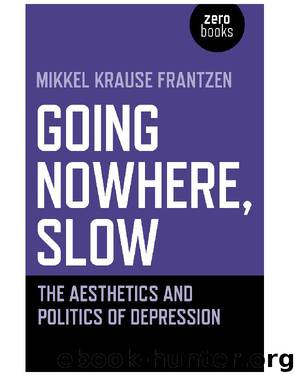Going Nowhere, Slow by Unknown

Author:Unknown
Language: eng
Format: epub
Published: 2020-01-31T16:00:00+00:00
One-two-three paradoxes (Threshold)
What the first two scenes of this chapter have shown regarding the problem of depression is that, whether the problem and pathology are related to a narcissistic self-consciousness and self-absorption, as is the case for the female protagonist in “The Depressed Person,” or to a sheer physical and mental pain, as is the case for Kate Gompert in Infinite Jest, the result is the same: A loss of empathy, a loss of the other as a category of futurity. In spite of the disparate nature of the two stories, with regard to content and form, this is the point of convergence characteristic of the experience of depression in Wallace’s works: “A person in such a state is incapable of empathy with any other living thing.”104
This is the problem of depression that Wallace presents and responds to. As we have seen in scene three, it is a problem that is inseparable from a more general and thoroughly American problem of addiction. What is articulated in Wallace’s work in general, and in Infinite Jest in particular, is that addiction to drugs is the mirror image of depression. Within the framework of this book, depression and addiction mirror each other in that a total isolation from the other – person or object – is at work in depression, whereas in addiction the issue is one of total immersion. While there is an obvious contrast between depression and addiction – isolation vs. immersion, detachment vs. attachment – and while the two meanings can thus be seen as opposed to each other, this may not necessarily be so. Both can be said, in Wallace, to form part of the same repetitive circle, the same loop of reflection, the same form of bad infinity, the same version of vicious infinite regress, which in the end (if not immediately) leads to a devastating loss of the future. And both lose the other, though from opposite directions so to speak. That is the pathological figure as Wallace exposes it, but there is another figure, one that contains the possibility for change, and of a therapeutic cure. This is the straight line that breaks open the circle and leads where, exactly? Into the unknown. It can lead to death and suicide, but it can lead to redemption, reparation and recovery too, it can lead to a restoration of the being of the other. As evidenced in scene four of this chapter a leap of faith is required, a radical work of love, a transcendent trajectory that disrupts the circular rhythm of pure pathology.
But is this leap of faith even possible for the depressed person, given that (s) he is depressed? Is there not something paradoxical in this demand? Kierkegaard notes this very paradox in Works of Love: “Humanly speaking, it is indeed most strange, almost like mockery, to say to the despairing person that he shall do that which was his sole desire but the impossibility of which brings him to despair. Is any other evidence needed
Download
This site does not store any files on its server. We only index and link to content provided by other sites. Please contact the content providers to delete copyright contents if any and email us, we'll remove relevant links or contents immediately.
Becoming by Michelle Obama(9912)
Beartown by Fredrik Backman(5575)
The Last Black Unicorn by Tiffany Haddish(5547)
Man's Search for Meaning by Viktor Frankl(4385)
The Book of Joy by Dalai Lama(3882)
In a Sunburned Country by Bill Bryson(3466)
The Five People You Meet in Heaven by Mitch Albom(3460)
Full Circle by Michael Palin(3365)
The Choice by Edith Eva Eger(3359)
The Mamba Mentality by Kobe Bryant(3170)
The Social Psychology of Inequality by Unknown(2922)
Book of Life by Deborah Harkness(2852)
Imagine Me by Tahereh Mafi(2809)
The Checklist Manifesto by Atul Gawande(2760)
Less by Andrew Sean Greer(2625)
A Burst of Light by Audre Lorde(2491)
The Big Twitch by Sean Dooley(2376)
No Room for Small Dreams by Shimon Peres(2306)
No Ashes in the Fire by Darnell L Moore(2288)
